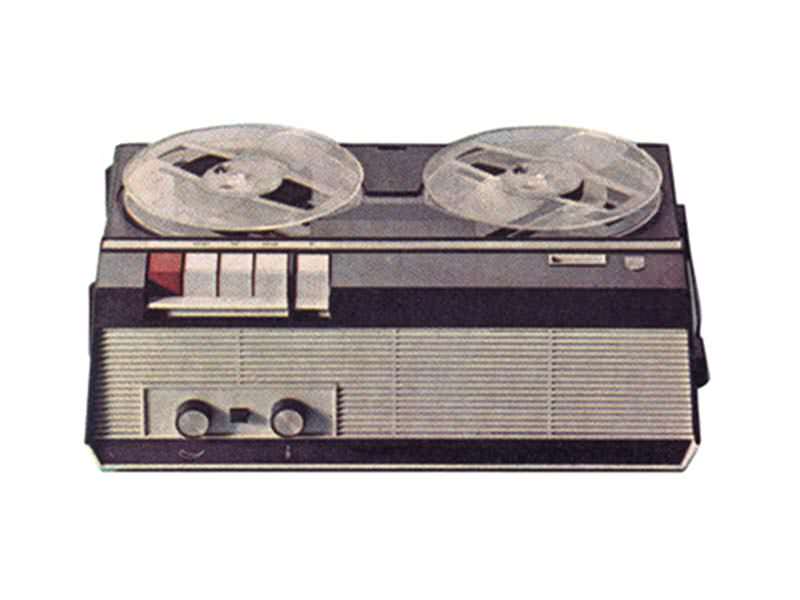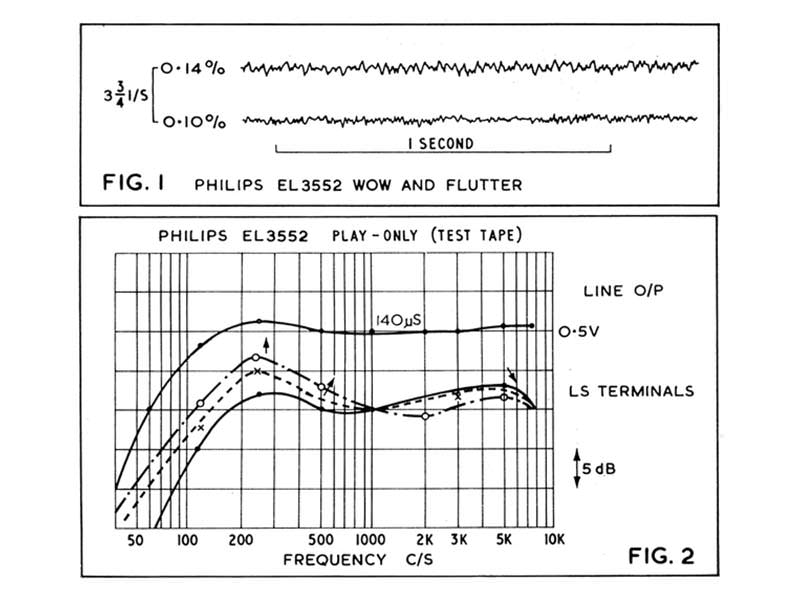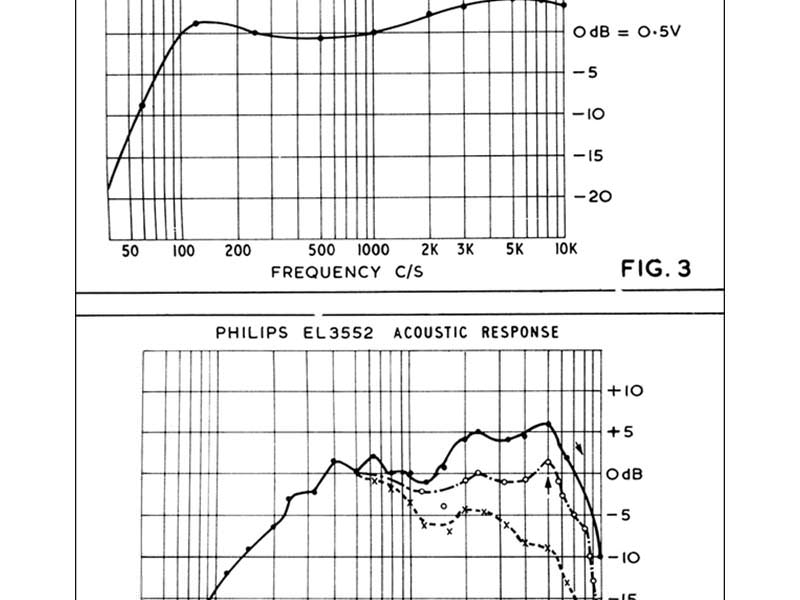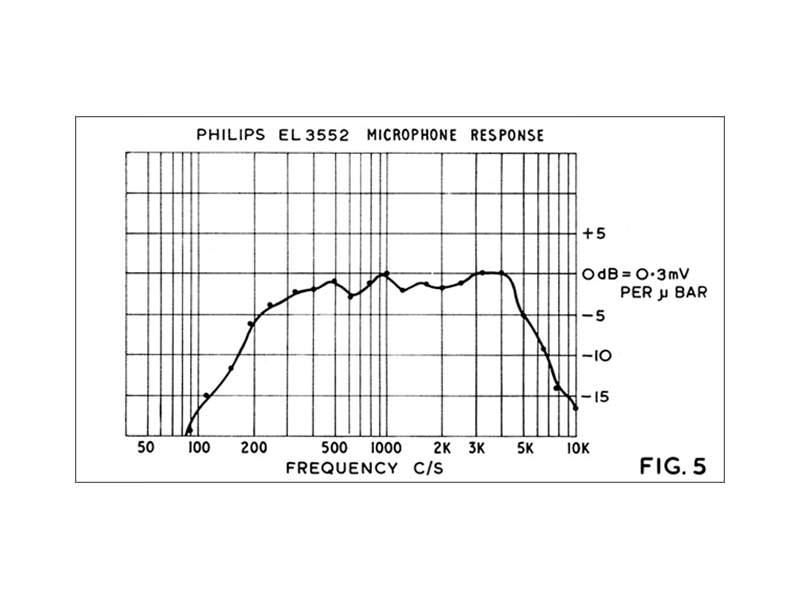Technical Details
Brand: Philips
Model:EL 3552
Category:Vintage
Application:Consumer
Electronics:Solid State
Equalization:IEC
Country of Manufacture:Netherlands
Release dates:1964 - 1967
Tracks:1/2 Rec/PB
Speeds: 3 3/4
Max Reel Size("): 5"
Number of heads: 2
Head Composition: Permalloy
Head Configuration: Mono - Half-Track
Voltage(s): 220-240v
Outputs: RCA
Frequency Response:( 3 dB): 80Hz - 12kHz
Wow and Flutter:0.2% (better than 0.6% peak to peak)
Signal-to-Noise Ratio:45 dB
Sound quality rating:6 / 10
Long-term reliability rating: 6/ 10
Additional Details
Description
A budget-priced domestic half-track mono recorder with a single speed of 3¾ ips and a reel
maximum reel size of 5¾”. The 3552 featured an automatic recording level and a single input which
could accept microphone, diode or gram and adjust the levels accordingly. Hybrid electronics (tube and solid state) were utilised.
Sold in the USA as Norelco Continental 95
Additional Info
By A. Tutchings, Tape Recorder February 1966
AFTER a surfeit of self-contained stereophonic recording and reproducing systems weighing up to 50lb., replete with every conceivable gimmick and gadget, it is a welcome relief to come down out of the clouds and deal with a homely little domestic recorder where everything has been made as simple as possible for the operator, but which, nevertheless, contains enough novel design features to make an interesting review.
This is another ‘automatic’ recorder which produces excellent recordings from microphone or radio without critical setting of the controls or constant monitoring of the magic-eye record level indicator. It is rather analogous to an automatic camera where you simply point it at the subject to be recorded and press the button.
There is only one socket, of the standard 3-pin DIN type, for the microphone or a combined input/output lead for recording from radio or feeding an external amplifier. The recording level is automatically set to suit the input signal unless the central button between the volume and tone controls is pressed to give manual control. On playback the volume and tone controls operate in the normal way.
As the very long time-constant required for automatic level control involves an inherently high impedance device, valves are used for most of the amplifier and control circuits. A transistor is used in the first stage to keep hum and noise to minimum level.
The deck mechanics are a dream of absolute simplicity: a single flat plate carries a motor at the rear R.H. corner driving a square cross-section belt which meanders around a number of idler wheels mounted on flat strips which are moved directly by the control keys; on the way the belt also drives the flywheel and capstan at a constant speed. For fast wind or rewind, the appropriate idlers are brought into contact with the reel hubs and the pressure roller moved away from the capstan. The stop bar, below the keys, releases all controls and applies simple servo-brakes to the reels.
The electronics are on another flat plate below the deck, with all parts and switches on a large printed circuit. The deck keys operate the switches by downward projections which engage with the printed circuit switches.
The wow and flutter performance is remarkably good considering the very long belt path. Fig. 1 shows that the RMS readings average 0.2%, with top and bottom limits of 0.14% and 0.10%. Wow is negligible, and the flutter is mainly at 25 c/s motor shaft rotation frequency which adds and subtracts to give the above mentioned flutter limits.
The play-only response of a recorder is important if it is to be used for playing pre-recorded tapes, which are recorded to a standard recording characteristic of 140uS for a tape speed of 3¾ i/s. Accordingly, a 140uS test-tape was used to obtain the responses shown in fig. 2. The line output (white lead on record/playback lead provided with the. recorder) remained at 0.5V within limits of ±3dB over the range 100 c/s to 7.5 Kc/s, which was the top frequency on the test-tape. The play response was also measured across the speaker terminals as the tone control only operates on the output stage. It will be seen that the voltage feed to the speaker is most constant with the tone control fully advanced.
The record-play response of fig. 3 was obtained by switching to manual control and applying constant tone levels to the red recording lead, and measuring the line output at the white lead on replay. The rise in high note response compared with the 140uS test-tape response of fig. 2 indicates that the recording characteristic is nearer 100uS on this machine.
A 500 c/s tone was recorded with the magic-eye beams just touching and the recording level was found to be only 7dB above test-tape level. Higher recording levels showed waveform distortion, which indicates that the tape was somewhat under-biased. (A properly biased tape should accept a level 12dB above test-tape level without distortion). The undistorted peak recording level was erased on the machine and the peak signal-to-noise and hum ratio was found to be 45dB, which agrees exactly with the specification.
Loud speech tests on microphone, with the automatic record level control in action, showed only momentary overload on the first syllable, with the rest of the test recorded perfectly. In the same way, signals recorded from radio via the recording lead were free of overload after the very first transient. The operating time of the circuit was much faster than the reaction time of a human control engineer. Recovery time to full sensitivity seemed to be in the region of one minute, but switching to play automatically discharges the time-constant to give full initial sensitivity on the next recording. No overload or evidence of automatic control was noticed if the radio signal was faded up over a period of 1-2 seconds. On microphone, even the first word overload can be prevented if the sentence is started with the microphone about 18 inches away and the microphone is brought nearer gradually.
The combined response of recorder and loudspeaker was measured by recording bands of filtered white noise on manual control and measuring the sound level on the axis of the speaker on replay. Fig. 4. shows that the electro-acoustic response is most nearest to level with he tone control at the halfway setting.
The microphone response was also measured in a white noise sound field to give the response of fig. 5. The response matches that of the recorder acoustic response over the range 200 c/s to 5 Kc/s.
COMMENT.
Nowadays everything is automatic, from the gear change on your car and the light setting of your camera to the landing of a jet plane with a hundred passengers aboard. The apparent simplicity of the operation should not hide the fact that tremendous amounts of research and development have gone into the perfection of such devices. In the case of the recorder, it was not a matter of developing the circuit—this was done many years ago for dictation recorders and for certain types of sound-on-film recorders. Rather it was a case of reducing production tolerances on certain components used for tape recorders: the tape itself had to be of known and constant sensitivity; magnetic heads had to be improved so that not only were the playback sensitivities more consistent but the recording sensitivity and bias requirements were constant from sample to sample. Production techniques had to be evolved to set the point at which the AVC came into action to exactly the right level, and to ensure that the controlled recording level corresponded to the overload point of the tape, having due regard to the bias setting used to give the best compromise between wide frequency response and harmonic distortion.
This, then, is the triumph of the EL3552 : to achieve all this at a selling price of 24 gns.
My only complaint: no extension speaker socket. But perhaps alter all it is not required by the type of customer for which this machine was designed. We boffins tend to assume that many recorders play into wide-range speakers to overcome limitations of the tiny speaker and cabinet of the average tape recorder, but we should probably be. shocked to find how few in fact are used in this way.
Rewind speed: 1200 ft in 3 minutes / Audio output power: 1.5 watts / Valve / semiconductor complement: ECC83, EL95, EF83, EM87, selenium rectifier and two low-noise transistors in the 1st stage / Inputs: microphone, diode & gram (single socket) / Outputs: 750mV at 20K for external amplifier / Speaker(s): internal 4″ (10cm) / Dimensions: 5 x 14¼ x 10″ (127 x 362 x 254 mm) / Weight: 12 lbs (5.45kg) / half-track mono





